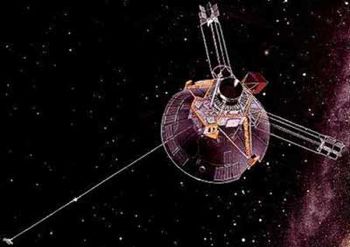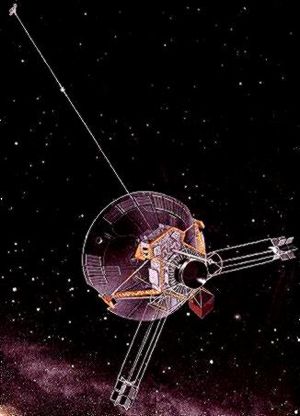Pioneer 10-11 (original) (raw)

Home - Search - Browse - Alphabetic Index: 0- 1- 2- 3- 4- 5- 6- 7- 8- 9
A- B- C- D- E- F- G- H- I- J- K- L- M- N- O- P- Q- R- S- T- U- V- W- X- Y- Z
Pioneer 10-11
American outer planets probe. Pioneers 10 and 11 were the first spacecraft to fly by Jupiter (Pioneer 10 and 11) and Saturn (Pioneer 11 only). Jupiter (10,11), Saturn (11) flyby satellite built by TRW for NASA, USA. Launched 1972 - 1973.
Status: Operational 1972. First Launch: 1972-03-03. Last Launch: 1973-04-06. Number: 2 . Gross mass: 258 kg (568 lb).
Instruments aboard the two craft studied Jupiter and Saturn's atmospheres, magnetic fields, moons, and rings, as well as the interplanetary magnetic and dust particle environment, the solar wind, and cosmic rays. Following their planetary encounters, the vehicles continued on escape trajectories from the solar system. Both spacecraft carry a plaque with a drawing depicting a man, woman, and the location of the sun and earth in the galaxy as greetings to any extraterrestrial who may find the vehicles.
Spacecraft
On-orbit dry mass: 258 kg. Spin stabilized at ~5 rpm. Attitude controlled by direction finding on communications radio beam. Hexagonal structure of aluminum with boron-epoxy tubes. Hydrazine propulsion with 6 x 1-lbf thrusters.40 AHr AgCd battery.49 kbits data storage.2.74 m diameter. parabolic HGA, medium gain and low gain antennas provide S-band communications from 2048 to 16 bps through NASA DSN stations. Deployable 6.6 m boom for magnetometer. One star (Canopus) sensor and two sun sensors for attitude knowledge. The spacecraft body was mounted behind a 2.74-m-diameter parabolic dish antenna that was 46 cm deep. The spacecraft structure was a 36-cm-deep flat equipment compartment, the top and bottom being regular hexagons. Its sides were 71 cm long. One side joined a smaller compartment that carried the scientific experiments. The high-gain antenna feed was situated on three struts, which projected forward about 1.2 m. This feed was topped with a medium-gain antenna. A low-gain omnidirectional antenna extended about 0.76 m behind the equipment compartment and was mounted below the high-gain antenna. Power for the spacecraft was obtained by four SNAP-19 radioisotope thermonuclear generators (RTG), which were held about 3 m from the center of the spacecraft by two three-rod trusses 120 degrees apart. A third boom extended 6.6 m from the experiment compartment to hold the magnetometer away from the spacecraft. The four RTG's generated about 155 W at launch and decayed to approximately 140 W by the time the spacecraft reached Jupiter, 21 months after launch. There were three reference sensors: a star sensor for Canopus which failed shortly after Jupiter encounter and two sun sensors. Attitude position could be calculated from the reference directions to the earth and the sun, with the known direction to Canopus as a backup. Three pairs of rocket thrusters provided spin-rate control and changed the velocity of the spacecraft, the spin period near the end of the mission being 14.1 seconds. These thrusters could be pulsed or fired steadily by command. The spacecraft was temperature-controlled between minus 23 degrees C and plus 38 degrees C. A plaque was mounted on the spacecraft body with drawings depicting a man, a woman, and the location of the sun and the earth in our galaxy.
Communications were maintained via (1) the omnidirectional and medium-gain antennas which operated together while connected to one receiver and (2) the high-gain antenna which was connected to another receiver. These receivers could be interchanged by command to provide some redundancy. Two radio transmitters, coupled to two traveling-wave tube amplifiers, produced 8 W at 2292 MHz each. Uplink was accomplished at 2110 MHz, while data transmission downlink was at 2292 MHz. The data were received by NASA's Deep Space Network (DSN) at bit rates up to 2048 bps en route to Jupiter and at 16 bps near end of the mission.
Payload
Fifteen experiments were carried to study the interplanetary and planetary magnetic fields; solar wind parameters; cosmic rays; transition region of the heliosphere; neutral hydrogen abundance; distribution, size, mass, flux, and velocity of dust particles; Jovian aurora; Jovian radio waves; atmosphere of Jupiter and some of its satellites, particularly Io; and to photograph Jupiter and its satellites. Instruments carried for these experiments were magnetometer, plasma analyzer, charged particle detector, ionizing detector, non-imaging telescopes with overlapping fields of view to detect sunlight reflected from passing meteoroids, sealed pressurized cells of argon and nitrogen gas for measuring the penetration of meteoroids, UV photometer, IR radiometer, and an imaging photopolarimeter, which produced photographs and measured polarization. Further scientific information was obtained from the tracking and occultation data. Pioneer 11 also carried a low-sensitivity fluxgate magnetometer.
More at: Pioneer 10-11.
Family: Outer planets. Country: USA. Launch Vehicles: Atlas, Atlas SLV-3C Centaur, Atlas SLV-3D Centaur. Projects: Pioneer series. Launch Sites: Cape Canaveral, Cape Canaveral LC36A, Cape Canaveral LC36B. Agency: NASA, NASA Ames, TRW. Bibliography: 2, 278, 296, 4017, 6, 12957.
Photo Gallery
 |
Pioneer 10Credit: Manufacturer Image |
|---|
1972 March 3 - . 01:49 GMT - . Launch Site: Cape Canaveral. Launch Complex: Cape Canaveral LC36A. LV Family: Atlas. Launch Vehicle: Atlas SLV-3C Centaur.
- Pioneer 10 - . Payload: Pioneer F. Mass: 259 kg (570 lb). Nation: USA. Agency: NASA Ames. Program: Pioneer. Class: Outer planets. Type: Outer planets probe. Spacecraft: Pioneer 10-11. USAF Sat Cat: 5860 . COSPAR: 1972-012A.
Jupiter flyby December 1973; first man-made object to leave solar system. The spacecraft achieved its closest approach to Jupiter on December 3, 1973, when it reached approximately 2.8 Jovian radii (about 200,000 km). As of Jan. 1, 1997 Pioneer 10 was at about 67 AU from the Sun near the ecliptic plane and heading outward from the Sun at 2.6 AU/year and downstream through the heliomagnetosphere towards the tail region and interstellar space. Additional Details: here....
1973 April 6 - . 02:11 GMT - . Launch Site: Cape Canaveral. Launch Complex: Cape Canaveral LC36B. LV Family: Atlas. Launch Vehicle: Atlas SLV-3D Centaur.
- Pioneer 11 - . Payload: Pioneer G. Mass: 259 kg (570 lb). Nation: USA. Agency: NASA Ames. Program: Pioneer. Class: Outer planets. Type: Outer planets probe. Spacecraft: Pioneer 10-11. USAF Sat Cat: 6421 . COSPAR: 1973-019A.
NASA's Atlas/Centaur was launched from Cape Canaveral carrying Pioneer 11 (Jupiter-Saturn). This was the first SLV-3D Atlas booster (vehicle 5011D), and the first SLV-3 to use the new 370,000-pound thrust MA-5 booster package for improved payload performance. Jupiter flyby December 1974; Saturn flyby September 1979. Solar system escape trajectory. Pioneer 11 was the second mission to investigate Jupiter and the outer solar system and the first to explore the planet Saturn and its main rings. Pioneer 11, like Pioneer 10, used Jupiter's gravitational field to alter its trajectory radically. It passed close to Saturn and then it followed an escape trajectory from the solar system. During its closest approach, December 4, 1974, Pioneer 11 passed to within 34,000 km of Jupiter's cloud tops. It passed by Saturn on September 1, 1979, at a distance of 21,000 km from Saturn's cloud tops. The spacecraft has operated on a backup transmitter since launch. Instrument power sharing began in February 1985 due to declining RTG power output. Science operations and daily telemetry ceased on September 30, 1995 when the RTG power level was insufficient to operate any experiments. As of the end of 1995 the spacecraft was located at 44.7 AU from the Sun at a nearly asymptotic latitude of 17.4 degrees above the solar equatorial plane and was heading outward at 2.5 AU/year. Routine tracking and project data processing operations were terminated on March 31, 1997 for budget reasons.
1973 December 3 - .
- Pioneer 10, Jupiter Flyby - . Nation: USA. Spacecraft: Pioneer 10-11.
1974 December 2 - .
- Pioneer 11, Jupiter Flyby - . Nation: USA. Spacecraft: Pioneer 10-11.
1979 September 1 - .
- Pioneer 11, Saturn Flyby - . Nation: USA. Spacecraft: Pioneer 10-11.
1995 September 30 - .
- Last transmission received from Pioneer 11 - . Nation: USA. Spacecraft: Pioneer 10-11.
Science operations and daily telemetry ceased when the RTG power level was insufficient to operate any experiments. As of the end of 1995 the spacecraft was located at 44.7 AU from the Sun at a nearly asymptotic latitude of 17.4 degrees above the solar equatorial plane and was heading outward at 2.5 AU/year. Routine tracking and project data processing operations were terminated on March 31, 1997 for budget reasons.
2003 January 22 - .
- Last transmission received from Pioneer 10 - . Nation: USA. Spacecraft: Pioneer 10-11.
The signal received was very faint with no telemetry received. NASA's Deep Space Network (DSN) did not detect a signal during the final contact attempt on 7 February 2003. The last time a Pioneer 10 contact returned telemetry data was 27 April 2002. NASA had no additional contact attempts planned for Pioneer 10. Pioneer 10 was at 82 AU, or 12.3 billion km from Earth. The last signal took 11 hours and 20 minutes to reach earth. The spacecraft was headed in the direction of the star Aldebaran, 68 light-years away. It would reach the vicinity of the red giant star in about two million years.
Home - Search - Browse - Alphabetic Index: 0- 1- 2- 3- 4- 5- 6- 7- 8- 9
A- B- C- D- E- F- G- H- I- J- K- L- M- N- O- P- Q- R- S- T- U- V- W- X- Y- Z
© 1997-2019 Mark Wade - Contact
© / Conditions for Use
